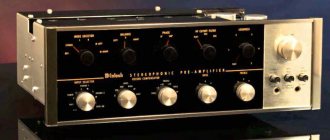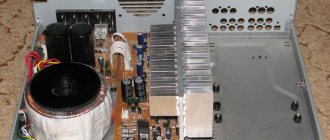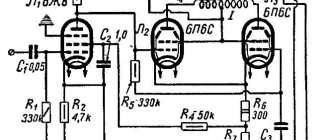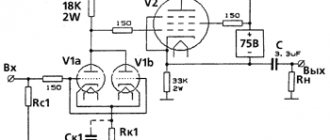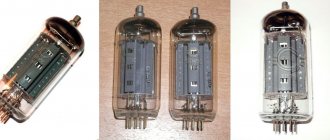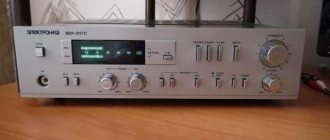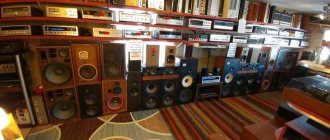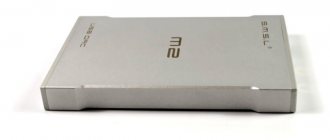Among radio amateurs, Soviet amplifiers are still popular to this day. Radio transmitting devices, acoustic systems for home theaters, electric guitars and other musical instruments are built on their basis. One big disadvantage for lamp-based units is that they require 220 Volt AC power, since the power transformer can only work with it. Therefore, it is problematic to use such amplifiers in “field” conditions. And the dimensions and weight of these devices are very impressive. What kind of low-frequency amplifiers were produced by Soviet industry?
The best Soviet amplifiers: photos and history
Among radio amateurs, Soviet amplifiers are still popular to this day. Radio transmitting devices, acoustic systems for home theaters, electric guitars and other musical instruments are built on their basis. One big disadvantage for lamp-based units is that they require 220 Volt AC power, since the power transformer can only work with it. Therefore, it is problematic to use such amplifiers in “field” conditions. And the dimensions and weight of these devices are very impressive. What kind of low-frequency amplifiers were produced by Soviet industry?
Serviceability/reliability
Nothing is digital (for the most part). There are no circuits or chips in these vintage amps that can fail. They can fail for other reasons - burnt/leaking capacitors, power supplies and the like.
How to repair and modify a vintage amplifier yourself
If you can read circuit diagrams and you can work with a soldering iron, then that's good, they are very easy to maintain. I personally avoid vintage amps that don't work.
"Electronics 50U-017S"
The appearance of this Soviet sound amplifier is very attractive - the silver body harmonizes perfectly with the chrome-plated control knobs. The power button is located on the left side of the front panel in the upper corner.
Below, in order, is the location of the controls and displays:
There is still an inconvenience - they use plugs with 5 pins, which you won’t find today. But if you wish, you can install adapters or completely get rid of the old connectors and install new RCA connectors in their place. If you do not modify the amplifier circuit, then in terms of playback quality it is much inferior to the ULF "Brig". But it beats Radiotekhnika U-101 or Vega in all respects.
Why are vintage amps good?
To avoid overusing convoluted tropes, they simply don't make them like they do now. For the most part, the companies listed here are just shadows of their former selves. The late 1970s and early to mid-1980s were a real golden age for audio equipment. Audio manufacturers have figured out how to create fantastic sound, and the “power war” has not yet begun. Nobody cared about power output, they cared about sound quality instead. Almost all the companies you will see in this guide are Japanese.
"Radio Engineering U-7111"
This is one of the best Soviet amplifiers, at one time it was the most “budget” option. But when compared with modern Chinese-made amplifiers, Radiotekhnika U-7111 is significantly ahead of them. The ULF kit included a tuner (radio signal receiver) and a player.
Externally, a very attractive amplifier, there is an equalizer with five-band adjustment. The front panel contains the following controls:
On the rear panel there are connectors for connecting audio sources - there are four in total. A maximum of two speaker systems are connected to the ULF output. There is also a ground terminal, fuse and sockets. In general, music lovers rate the sound as good, but out of 5 points, the maximum is 4 plus.
"Brig U-001": description
One of the best Soviet high-class amplifiers is the Brig U-001. The sound quality is very high, but only if you use a good speaker system. The ULF holds the bass very well and there are no extraneous sounds at all. When listening to music at high volume, the speakers are not blocked, which allows you to enjoy the music to the fullest.
Mid and high frequencies are also transmitted well by the amplifier - they stand out brightly, so listening to jazz, blues, and orchestral music will be great. Everything is great, but the amplifier weighs more than 25 kg. Despite the excellent reproduction of live music and films, it is worth talking about the drawback - it is uncomfortable to listen to rock and metal on it.
"Corvette 100U-068S"
Another Soviet amplifier, in some respects it is not inferior to the Brig described above, but overall it is a little worse.
The front panel of the ULF contains the following controls and indications:
When connecting an 8 Ohm speaker system, the power is 60 W, 4 Ohm - 90 W. Maximum power consumption – 275 W. A huge disadvantage of the device is the plastic body, since the mass of the amplifier is very large. The very reliable technical part of the amplifier is balanced by the poor quality of the housing and controls.
"90U-2 Kinap"
You can’t ignore such a legend, because it was with his help that most Soviet people heard the voices of their favorite actors. This is a Soviet tube amplifier that was used in mobile film installations.
The number of adjustments is not amazing, like those described above - there is an adjustment for volume, low and high frequencies, and an overload indication lamp. There is also a window on the top to which a device was connected that reads sound from the film strip.
Vintage Yamaha Amplifiers
Yamaha had a stranglehold on the audio market throughout the early to mid-80s. They are known for their insane performance, sounding clear and fast through the amps. Their vintage aesthetic is still used in their modern products. However, modern ones do not reach the Hi-End class.
Yamaha CA-2000 amplifier
The vintage Yamaha sound is similar to the Kenwood sound, but even more analytical and not as soft.
Why is music for the people?
Soviet industry began producing separate amplifiers for home stereo systems already in the transistor era, while tube amplifiers were produced before that either as part of radiograms or for industrial use. Moreover, most transistor devices belonged to the class that in the West is usually called Low-Fi. However, there were also attempts to make really high-quality devices, although they were not always able to be implemented in the intended form.
Like all Soviet devices designed to operate in a quadraphonic system, this amplifier was produced in a very small batch. If the format has not received proper distribution throughout the world, then what can we say about the Soviet Union. Since 1975, this device has been produced by the Lvov Production Association named after. Lenin and was supposed to be supplied complete with four speakers; stereo outputs and quadraphonic headphones were also provided. The signal level was adjusted channel by channel and controlled by dial indicators. The power in quadraphonic mode was 16 watts per channel, when operating in stereo it doubled. The model weighed 15 kilograms and was offered for 500 rubles.
This complete amplifier has been produced by the Riga Radio Plant named after Popov since 1977. It had a built-in phono stage, as well as a full set of line inputs, and it was also possible to connect headphones. On the left side of the front panel there were arrow indicators for the output signal level, and the kit also included a wireless remote control - a rarity in those years. The amplifier power was 50 watts per channel at 8 ohms, the weight of the device was 12 kilograms. The model cost 350 rubles.
This stereo amplifier has been produced by the Leningrad Kalinin Plant since 1987. It had a built-in phono stage, low-pass and high-pass filters and a tone block, as well as loudness. The output signal power indicators were electronic. There was also a headphone output on the front panel. The output stages were protected against short circuits, overheating and the presence of constant voltage. The rated power was 100 Watts at 8 Ohms, the THD did not exceed 0.05%, the intermodulation distortion coefficient did not exceed 0.01%. The device weighed 17 kilograms.
The model was produced by Kirovsky, who produced it since 1987. It used the technical solutions of the Brig-001-stereo amplifier, and for the first time used a LAN-class power amplifier with two-level power supply. The built-in phono preamplifier could work not only with MM, but also with MC heads, and the volume control had variable loudness compensation. The rear panel also had a power outlet for connecting other system components. The amplifier output power was 60 watts per channel, and the stated frequency range was from 10 to 70,000 Hz. The device weighed 10.8 kilograms and cost 650 rubles.
Since 1981, this power amplifier has been produced by the Lviv Production Association named after the 50th anniversary of October. It was part of the Phoenix-005C stereo complex, which cost mind-boggling money at that time - 3,400 rubles. For those years and the domestic class of equipment, it had a very solid rated output power - 2 x 100 Watts, its maximum performance reached 2x180 Watts.
Legendary amplifiers - historical “anatomy” of trends: reflections on quality, prices and trends
Over the past 60 years, the idea of developers and consumers about what a good UMZCH is has changed many times. However, amplifiers periodically appeared that, thanks to circuitry and design solutions, remained in history as symbols of their era, as standards of quality, as devices that predetermined the development of entire trends.
Analyzing the history of the appearance of the so-called iconic UMZCH over a long period of time, several interesting phenomena can be noted. I will talk about some of them in this article, which, if the user ratings are positive, will become the first in a new series of posts. Today we’ll look at the expensive and not so high-end, what it grew from, what it was, and what it has become.
As the basis for the material, I took reviews of such people as: Peter Breuninger, Dick Olsher, Harry Pearson, etc., as well as a number of publications reflecting the historical significance of devices and the formation of some brands. As it turned out, despite some discrepancies, the authors’ conclusions about the “cult” and historical significance of many famous amplifiers are quite correlated.
Eloquent silence
Already at the stage of analyzing sources, I came across the following: magazines for audiophiles and sympathizers, when it comes to a mass-produced and inexpensive device, do not indicate the price of the device. At the same time, if at the time the component appeared on the windows it cost several tens of kilobucks, then the price is mentioned almost immediately and attention is focused on it (indicating that this price tag was in such and such a year, and this takes into account dollar inflation et setera).
I decided to fill these gaps and found the cost of some devices that were not included in the reviews of seasoned sound experts. One more point, it is connected with the fact that the audio press of the 70s - 90s did not bother themselves, as unnecessary, apparently, with indicating the exact characteristics of the devices they wrote about.
Dynakit (Dynaco ST-70) – DIY kit for the audiophile
This revolutionary product for its time was developed by American sound engineer David Hafler. In 1954, Hafler founded Philadelphia with fellow hi-fi designer Ed Laurent. By 1959, serial production of the ST 70 tube amplifier was launched, which, in a cheaper version (“Dynakit”), was intended for self-assembly.
The audiophile designer's simple and efficient circuit design involved the use of four EL34 tubes, one GZ34/5AR4 and two 7199. The impressive amplifier design was developed by Ed Laurent and Bob Tucker, who used nickel plating on the cabinet surfaces for shielding purposes. This feature also had a positive effect on the aesthetics of the device.
RMS - 35 W (PMPO: 80 W) Response - 10 Hz
40 kHz at ±0.5 dB. Total THD - less than 1%. (20 Hz
20kHz, with 35 W & with 1 dB) IM Distortion - less than 1% with 35 W & less than 0.05% with 1 W. Distortion Noise & hum: 90 dB with RMS. Output impedance - 4, 8 and 16 Ohm. Damping factor: > [email protected] to 1KHz
Concert macs of the grateful dead or “warm” tube psychedelia
Today, the McIntosh MC-3500 is the dream of many music lovers and audiophiles nostalgic for the 60s. Audio chroniclers classify it as the so-called True Hi-end. At the same time, the titled UMZCH did not begin its journey in the showrooms of expensive audio stores or in personal studios for listening to music.
The McIntosh MC-3500 was the workhorse of serious concert venues, rehearsal facilities and recording studios. This device was initially positioned as a professional equipment, and only 3-4 years after gaining a reputation as an indestructible and excellent-sounding amplifier for professionals, it was “adopted” by audiophiles.
Like most equipment of its time (manufactured in 1968), the McIntosh MC-3500 was a tube-based one. The characteristics of the device met the requirements of the best concert venues and studios of that time:
Semiconductor standard of the 70s
It is worth noting that this amplifier is worth the money, as its characteristics eloquently speak of, without pretentious advertising:
The amplifier was appreciated by its contemporaries; they bought a lot, more than 100,000 units from 1977 to 1982. Paradoxically, tube-orthodox audiophile criticism (in magazines like Stereophile, Pride Audio, etc.) highly appreciated this blatant example of transistor-semiconductor soullessness, with a ridiculous (for Hi End) price tag, noting in particular:
“Many transistor amplifiers, then and now, exhibit impressive performance characteristics, but little more than a sterile, dead sound. That is, he lacks emotional intensity.
This is always different with the Ampzilla II amplifier. Its rhythmic, dynamic presentation captivated all music lovers, while music lovers sought to find more and more detail in the high-frequency spectrum.”
Toroidal monsters of our days
I will deliberately not dwell on several stages of degradation in the evolution of high-end music in the 80s, 90s and noughties (if there is a cycle, we will certainly return to them). I will skip this long transitional stage so that you can feel the contrast between what was done and valued then and what is done and valued now.
Lyrical digression. I’m not sick of retrograde, I don’t pray for vintage, I love and respect progress. I won’t, with the air of a wise old man, talk about “how cool it was” when I wasn’t there, no. But I want readers to note the dominant concepts in which devices that are considered iconic (then “cult”, and now “cult”) are made. So, are you ready? Drumroll…
Source
Review of Soviet sound amplifiers
The Soviet Union produced a lot of different household and professional electronic equipment; it was one of the largest manufacturers in the world. Radio sets, tape recorders, radios and much more were on sale. This article will be devoted to a very important device - a sound amplifier.
Story
It so happened that in the USSR there were no high-quality amplifiers until the end of the 60s. There are many reasons for this, including: a lag in the element base, the industry’s focus on military and space tasks, and a lack of demand among music lovers. At that time, audio amplifiers were mostly built into other equipment, and it was believed that this was enough.
Some domestically produced amplifiers such as “Electronics-B1-01” and others could not boast of high sound quality. But by the beginning of the 70s the situation began to change. Demand began to emerge, so groups of enthusiasts arose who began developing appropriate equipment. Then the leadership of ministries and departments began to realize that the gap from Western models was quite impressive and needed to be caught up. As a result of the confluence of these factors, by 1975 an amplifier called “Brig” was born. It was probably one of the first production samples of high-class Soviet equipment.
Let us remember that at that time, our consumer electronics were divided into classes. The first digit in the name of the device meant its class. And it was enough to look at the device’s labeling to understand which segment it belongs to.
The highest-class equipment, to which “Brig” belonged, had zeros first in its name, “premium” proudly bore a one in its name, “middle” had a two in its name, and so on, up to class 4.
Speaking about the Brig, one cannot help but remember its creators. These were engineer Anatoly Likhnitsky and his comrade-in-arms mechanic B. Strakhov. They literally created this miracle of technology on a voluntary basis. These two enthusiasts, due to the lack of high-quality equipment, decided to create it themselves. They set themselves serious challenges and succeeded in designing the perfect amplifier. But, most likely, it would have remained in two copies, if not for Likhnitsky’s acquaintance with influential officials of Leningrad through “music lovers” affairs. By that time, the task was already to create a high-class amplifier, and they decided to attract a talented person to this work.
Vintage Kenwood Amplifiers
Modern Kenwood amplifiers are definitely not what they used to be. Kenwood amps from the late 70's are simple, beautiful and very functional.
kenwood_ka-1000_stereo
Nowadays, vintage Kenwood is extremely affordable, has solid features and is not as sought after as some other brands. The sound of Kenwood is neutral and has a hint of softening, with a little "smooth cream" added.
Kenwood Supreme
Peculiarities
To make the equipment sound more powerful, you will need an audio amplifier. In some samples it may be built into the device, while in others it will need to be connected separately. This is a special electronic device whose task is to amplify sound vibrations in the range of human hearing. Based on this, the device should operate in the range from 20 Hz to 20 kHz, but amplifiers may have better characteristics.
By type, amplifiers range into household and professional. The first ones are intended for use at home for high-quality audio playback. In turn, equipment in the professional segment is divided into studio, concert and instrumental.
By type of device they are divided into the following types:
When choosing, you should pay attention to the number of channels, power and range of reproduced frequencies.
And don’t forget about such a feature of Soviet amplifiers as five-pin connectors for connecting devices. To connect modern devices to them, you will have to buy or make a special adapter yourself.
Model rating
At this stage of electronics development, many music lovers may say that Soviet sound amplifiers do not deserve attention. Foreign analogues are both better in quality and more powerful than their Soviet brothers.
Let's just say this statement is not entirely true. There are, of course, weak models, but among the highest class (Hi-Fi) there are several worthy examples. At a low cost they produce very decent sound.
Based on user reviews, we decided to make a rating of household amplifiers that are worth showing interest in.
The only drawback of the device is its weight, it is 25 kg. Well, it is increasingly difficult to find in the original factory version.
Over time, the façade panel becomes simply horrific. But the amplifier's features and excellent parameters can outweigh this minus.
This device is capable of producing sound with a power of 50 watts per channel. The sound is very pleasant, and even rock sounds high quality.
This device produces a very clear and pleasant sound. Recommended for lovers of live music.
Of course, it is not suitable for audiophiles, but it is just right for beginning music lovers with a small budget.
AESTHETICS
Most of them are just awesome. They are nice to look at and usually even better to interact with. Everything is simple... analog, physical. The volume and tone knobs and switches are large, with audible and tactile feedback.
NAD-2600 and nad-1300
Many people just like to tinker with the controls, even if there is no reason to do so. It is very nice. Vintage cars are cool. Just like vintage audio.
Amplifier clone NHB-108
I hope this article, How to Repair and Modify a Vintage Amplifier Yourself, helped a little. Please leave comments below so we can get back to you.
If you want to know more about this topic and stay updated, please subscribe to our website.
I wish you good luck in finding your sound! On our website Zvukomania there is useful information on sound and video that is useful for everyone, and for every day, we update the Zvukomania website constantly and try to search and write only excellent, verified and necessary information.
Source

